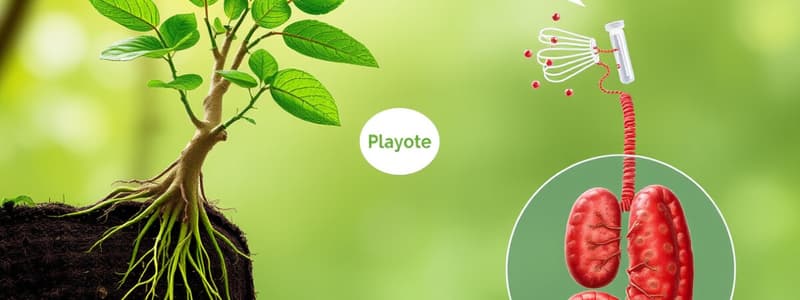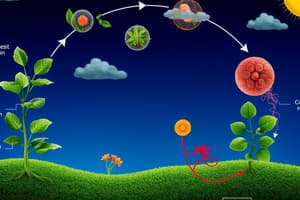Podcast
Questions and Answers
How do autotrophs contribute to the rapid carbon exchange in the carbon cycle?
How do autotrophs contribute to the rapid carbon exchange in the carbon cycle?
Autotrophs capture carbon dioxide from the air or bicarbonate from water through photosynthesis and convert it into organic compounds like glucose.
What role do decomposers play in the carbon cycle?
What role do decomposers play in the carbon cycle?
Decomposers break down dead organisms or waste, releasing carbon back into the atmosphere as carbon dioxide and returning nutrients to the soil.
Describe the slow carbon cycling process and its significance.
Describe the slow carbon cycling process and its significance.
Slow carbon cycling involves geological processes that store carbon in sediments, oceans, and fossil fuels over millions of years, significantly influencing atmospheric CO2 levels.
What happens to carbon in marine organisms after they die?
What happens to carbon in marine organisms after they die?
Explain how fossil fuels form in relation to the carbon cycle.
Explain how fossil fuels form in relation to the carbon cycle.
What is the connection between atmospheric CO2 levels and ocean reservoirs?
What is the connection between atmospheric CO2 levels and ocean reservoirs?
How does cellular respiration contribute to the carbon cycle for both autotrophs and heterotrophs?
How does cellular respiration contribute to the carbon cycle for both autotrophs and heterotrophs?
What geological process can release carbon dioxide back into the atmosphere, and how does it work?
What geological process can release carbon dioxide back into the atmosphere, and how does it work?
In what ways does the carbon cycle affect aquatic ecosystems specifically?
In what ways does the carbon cycle affect aquatic ecosystems specifically?
Discuss the impact of human activities on the carbon cycle.
Discuss the impact of human activities on the carbon cycle.
Flashcards are hidden until you start studying
Study Notes
Rapid Carbon Exchange
- Occurs among living organisms through cellular respiration and photosynthesis.
- This process is fast, linked to activities like breathing.
- Carbon exists in the atmosphere as CO2 and forms bicarbonate (HCO3) when dissolved in water.
- Autotrophs capture CO2 or bicarbonate and convert it into organic compounds like glucose (C6H12O6) through photosynthesis or chemosynthesis.
- Heterotrophs, such as humans, consume organic molecules from producers, passing carbon through food webs/chains.
- Energy stored in carbon molecules is released via cellular respiration, returning CO2 to the atmosphere.
- Decomposers break down dead organisms or waste, releasing organic compounds and CO2, facilitating rapid carbon cycling, especially in aquatic ecosystems.
Long-term Carbon Cycling
- Operates over millions of years through geological processes.
- Involves storage of carbon in the atmosphere, oceans, sediments, and soil.
- CO2 levels in the atmosphere are influenced by ocean carbon reservoirs and vice versa.
- In oceans, CO2 dissolves to form bicarbonate, which reacts to produce carbonate ions (CO3), essential for marine life shell formation.
- Marine organisms' remains contribute to ocean floor sediment, eventually forming limestone, the largest carbon reservoir on Earth.
- On land, carbon storage occurs in soil through organic matter decomposition and inorganic weathering of rocks and minerals.
- Fossil fuels, formed from plant remains under anaerobic conditions over millions of years, reside deep underground.
- Combustion of fossil fuels releases carbon into the atmosphere as CO2.
- Additional carbon enters the atmosphere via volcanic eruptions and tectonic plate movements that shift oceanic sediments.
Studying That Suits You
Use AI to generate personalized quizzes and flashcards to suit your learning preferences.




